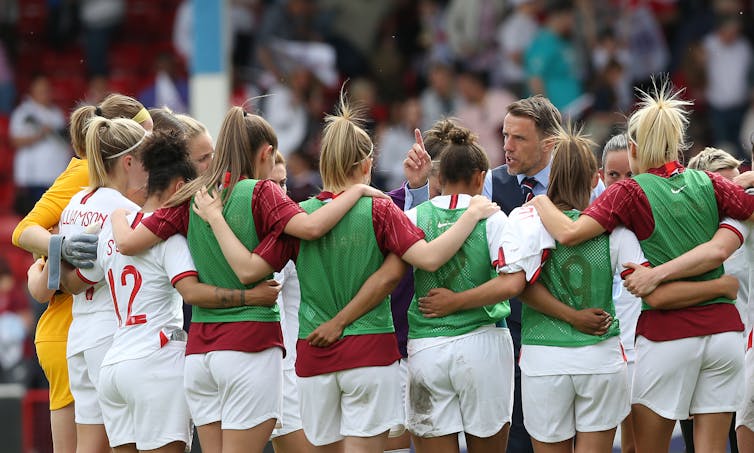As the Women’s World Cup gets underway, football fans around the world are looking forward to getting the chance to see the likes of Danielle van de Donk (Arsenal and Holland), Megan Rapinoe (Reign FC and USA ) and Lina Magull (Bayern Munich and Germany) in action on the biggest stage the “beautiful game” can offer.
While the US are favourites, England have had a successful build up to the tournament with a win in the SheBelieves Cup in the US in February as well as a recent 2-0 win against Denmark. The team is currently ranked third in the world behind the US and Germany.
Over the past two decades there have been major developments in women’s football. These include the creation of the UEFA Women’s Champions League in 2001 and the inclusion of women’s football in the 1996 Atlanta Olympics. In 2011 Sepp Blatter, the general secretary of FIFA, declared that: “The future [of football] is feminine”.
But football also has a feminine past, having been around in the UK since the early 1900s. During World War I the Dick, Kerr ladies, formed at a munitions factory in Preston, attracted crowds of more than 50,000 people at Goodison park playing St Helen’s ladies. But the glory was shortlived – the FA banned the women’s game in 1921, calling on clubs to “to refuse the use of their grounds for such matches”. The ban wasn’t lifted until 1971.
Modern era
Since women’s football was reinstated, many famous teams have dominated the female game in England. The Doncaster Rovers Belles, Arsenal Women, Everton Ladies, Liverpool F.C. Women and – more recently – Manchester City and Chelsea have set new standards within the women’s game. Professional contracts were introduced by the England women’s team in 2009 the Women’s Super League was formed in 2011 and became a fully professional league in 2017/2018 season. Participation in women and girls football was estimated at 1.7 million in 2018.
But when it comes to salaries women are not in the same ballpark as men – the average salary in the FA Women’s Super League is about £35,000 (with top sponsorship deals at about £70,000). As a result, many players can’t support football solely as a career and will need to supplement this with part-time jobs.
Level playing field
Knowing that they have to combine football with another career has helped many women players with transitions away from football, because they have to plan for retirement and accept that their football earning cannot sustain them for life – unlike their vastly better-paid male counterparts. Research I completed in 2017 addressed the careers of women footballers across Europe (Denmark, England, Finland, Germany, The Netherlands and Norway). The study included players from England’s national team and highlighted challenges faced by women players. Among these were the immature football structures at club level compared to the male game and the fact that many players have to migrate to other countries to play in professional and semi-professional leagues.

Women also have less access to top-class facilities and have to overcome societal attitudes, which have tended to pigeonhole the women’s game as inferior to men’s football.
The report made several recommendations, such as the implementation of a new junior age structure at club level for the under-18, 21 and 23 age groups are needed to help with the transition into senior teams. We’ve already seen how successful that can be with the introduction of age groups at the international level.
Establishing full-time women’s professional leagues around the world will help football associations to retain players in their own country. There are presently full-time professional leagues in England, Norway, Germany, USA and Sweden and semi-professional leagues in The Netherlands and France. My research highlighted the challenges that players face when migrating to another country to play professional football – similar to the men, women players moving countries face learning a new language, settling into a new culture and moving away from family and friends. Unlike the men, they aren’t supported by fame and huge salaries.
Regardless of where they are, football associations and clubs need to provide specific career advice for players to help them plan a career after football and provide sufficient time and resources to allow players to gain qualifications as well as training to prepare them to transition out of their playing career. This is something the EU has promoted with its directive to protect the access that athletes have to educational opportunities and vocational training.
Planning for the future
My research also highlighted the fact that many female football players are under pressure to postpone having children because of the fear that it will affect their playing career. I believe it’s vital for football associations to include in their welfare policies measures to ensure a supportive environment for players to have children while continuing to play football. Clubs must be required to put in place support mechanisms to allow for this to happen. For example, if players are away at major tournaments for several weeks, they must be offered support to allow their children to accompany them.

Over the next few weeks we’ll be treated to some truly stellar football skills from the finest women players in the world. These women have dreamed of this moment for years and trained as hard as any men to make that dream come true. As you thrill to the sight of Van de Donk, Rapinoe and Magull in full flow on the game’s biggest stage, ask yourself: shouldn’t women be given the same chance to shine as men?

